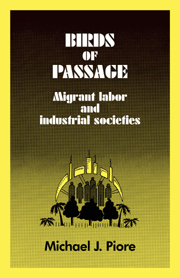Book contents
- Frontmatter
- Contents
- Preface
- 1 Introduction
- 2 The jobs
- 3 The migrants
- 4 Particular characteristics of the migrant labor market
- 5 The impact of migration on the place of origin
- 6 The historical evolution of long-distance migration in the United States
- 7 The dilemmas of current U.S. immigration policy
- Notes
- Bibliography
- Index
6 - The historical evolution of long-distance migration in the United States
Published online by Cambridge University Press: 28 October 2009
- Frontmatter
- Contents
- Preface
- 1 Introduction
- 2 The jobs
- 3 The migrants
- 4 Particular characteristics of the migrant labor market
- 5 The impact of migration on the place of origin
- 6 The historical evolution of long-distance migration in the United States
- 7 The dilemmas of current U.S. immigration policy
- Notes
- Bibliography
- Index
Summary
This and the subsequent chapter review the migration experience of the United States in terms of the analytical perspective developed in the foregoing pages. The present chapter focuses on the historical evolution of long-distance migration flows. The next chapter is directed at the contemporary policy problems posed by undocumented alien workers. The chapters are designed to illustrate, through the examination of the American case, the type of interpretation that the analytical perspective implies. But they also represent an attempt to demonstrate the usefulness of the approach as a means of understanding and coming to terms with the specific problems that such migration poses for public policy.
The history of migration flows in the United States may be analyzed in terms of two distinct developments, the evolution of the job structure, or the demand for long-distance migrants as workers, on the one hand, and the evolution of the migration streams, or the supply of migrants, on the other. This chapter is divided accordingly.
The demand for labor: the structure of the labor market
A careful study of the historical development of labor-market structures remains to be undertaken; in the absence of such a study, our understanding of the development must remain incomplete and fragmentary. Nonetheless, available material suggests that in the United States five periods were of critical importance, particularly in the formation of the low-wage, or secondary, sector into which unskilled immigrants have flowed: (1) a preindustrial or craft stage; (2) a stage of incipient industrialization, in which industrial and agricultural activities were combined within the same productive units; (3) the development of factory production, (4) the formation of large manufacturing trusts in the late nineteenth and early twentieth centuries; and (5) the introduction of social-welfare reforms and the formation of industrial unions in the 1930s and 1940s.
- Type
- Chapter
- Information
- Birds of PassageMigrant Labor and Industrial Societies, pp. 141 - 166Publisher: Cambridge University PressPrint publication year: 1979
- 1
- Cited by



